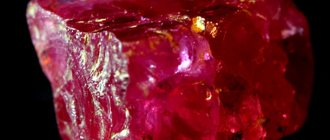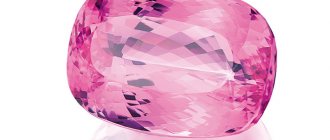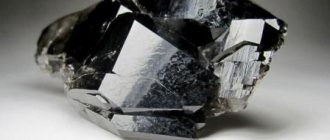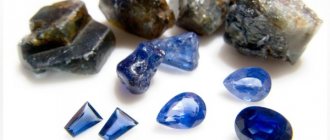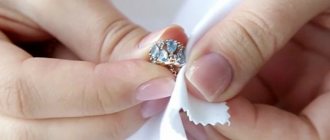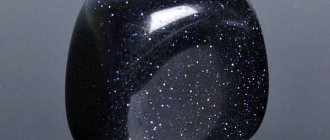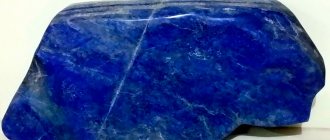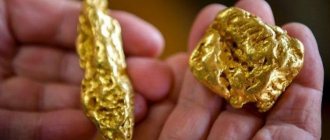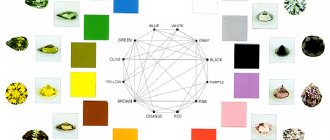Natural topaz is a very popular stone among fashionistas all over the world. For this reason, many unscrupulous entrepreneurs in the jewelry business want to make money from people who have little understanding of minerals. Due to the high prevalence of counterfeits, a completely reasonable question arises: how to determine the authenticity of topaz? People have wondered about this since ancient times, because even then there were cunning people who passed off cheap stones as semi-precious minerals or simply painted a colorless gem red or green in order to sell it at a higher price. From this article you will finally learn to understand that this is a fake gem and not an artificial topaz.
BIG DIFFERENCE: PROCESSED OR ARTIFICIAL
Processed stones stand apart from real and fake gems.
It is difficult to call processed minerals “artificial”: they are almost identical to real ones.
| PROCESSED |
|
| ARTIFICIAL |
|
How to determine the authenticity of topaz at home
Real topaz
If you are interested in how to determine the authenticity of topaz, it is important to know the properties that are inherent in this stone. Then it will be much easier for you to check the existing sample even at home.
First you need to pick up the stone and take a good look at it. The original will have a perfect polish and will be smooth to the touch. The silky and even slippery feeling will help you identify real topaz.
Another way to distinguish a natural topaz stone is to check its hardness. The natural mineral will easily leave a scratch if you run it across a glass or crystal surface. But such manipulations must be carried out with great care so as not to harm the cut of the crystal.
How to distinguish real topaz will be helped by its ability to become electrified. Synthetic samples and other imitations do not have this ability. To check, simply rub the gem with a piece of woolen cloth and bring it to small pieces of paper or hair.
The natural mineral will attract them to itself. In addition, it heats up quite slowly, so when you take the pebble in your hand, you should feel that its surface is cool.
A sign by which topaz can be distinguished from a fake is the heterogeneous structure of a real crystal. Most real gems have small defects and uneven color. The same jewelry that is absolutely transparent and has an even shade is very rare and is valued very highly.
If, upon careful examination, you notice cracks in the stone that are located in parallel, then, most likely, this is a real sample, whose crystal lattice determines such a structure.
When choosing jewelry, it is worth considering that natural stones cannot be cheap. This also applies to topazes of unusual colors and too bright shades. Such examples are very rare and cost incredible amounts of money. Therefore, if you are offered a large transparent stone of a bright color at a low cost, this is without a doubt an imitation.
VARIETY OF TOPAZES AND FINISHES
Blue
The blue shade is the most recognizable: most people associate topaz with it. Shades range from pale to deep blue, or “London”.
Synthetic topaz is usually also blue. Rare natural cornflower blue minerals are mined in Brazil.
We recommend: FIANIT - a laser part and a “poor man’s diamond”
Champagne
Truly regal and luxurious - a champagne-colored mineral. Such stones are often counterfeited - after all, the shade is rarely found in nature and costs hundreds of dollars.
Imperial
Imperial are called yellow, orange or red topazes. Despite their beauty, these stones are not in demand.
The rarest imperials are pink minerals. By the way, a natural stone is unmistakably distinguished by its pink hue: like colorless topaz, such topaz cannot be faked.
Rauchtopaz
“Smoky” (translated from German) topaz is nothing more than a type of quartz. Sellers may “forget” to explain this difference. The gem is a beautiful and deep brown shade, but should be sold as quartz.
Characteristics and properties of the mineral
The following minerals can be distinguished among plagioclases:
- anorthitis
- andesines
- oligoclases
- labradors
- bitovnites
- albites.
Plagioclase is classified as aluminosilicates. The basis of such minerals is silicon, aluminum and oxygen. When calcium or sodium is added to these substances, plagioclase is formed.
The percentage of calcium and sodium content in plagioclases has a wide range. Albite contains no calcium at all; it is designated by the formula NaAlSi3O8. Anorthite does not contain sodium, the formula is CaAl2Si2O8. The remaining minerals are a mixture of albite and anorthite in different proportions. Instead of a name, they are often given a number, which depends on the percentage of anorthite. For example, mineral No. 98 consists of 98% anorthite and 2% albite.
Oligoclase is characterized by a high sodium concentration. Labradorite contains a slightly lower percentage of sodium, and bitovite contains very little.
In addition to sodium and calcium, plagioclases may contain impurities of other metals: iron, barium, calcium, strontium.
Plagioclases consist of asymmetrical grains of irregular shape. The grains are most often elongated, and their size does not exceed 1 millimeter. But sometimes the length of the grains can reach 3.5 millimeters.
All plagioclases consist of thin plates arranged parallel to each other. They can be clearly seen under a magnifying glass.
Plagioclases have different shades. The most common colors are white, gray, and slightly greenish. Often the mineral has foreign inclusions that can make it almost completely black.
If plagioclase contains hematite, the mineral has a red tint with a golden tint. Due to this, it is called the sun stone.
Minerals have different properties, which depend on the percentage of anorthite and albite, as well as the presence of foreign impurities in the rock. The melting point ranges from 1100C (albite) to 1550C (anorthite).
The density is less dependent on the composition and is equal to 2.7 grams per cubic centimeter. The mineral is characterized by a high hardness index. On the Mohs scale it ranges from 6 to 6.5 points.
Plagioclase has a characteristic glassy luster. It can be translucent or matte. If the stone had a completely transparent structure, it could be considered precious.
What zodiac signs is it suitable for?
The talisman stone must be selected in accordance with the horoscope so that energetic compatibility with it is achieved. Depending on the predominant shade of mystic topaz, it will have a different effect. Who should wear the mystical quartz topaz stone?
It will be the most suitable talisman for Scorpios and Geminis, for them it will best demonstrate all its properties; is categorically not suitable for Taurus, but for all other signs it will have a moderate positive effect.
Taurus
This is the only zodiac sign for which the stone will be hostile. There are numerous cases where the mystic topaz attracted all sorts of troubles to Taurus and provoked a break with loved ones and depression. Therefore, they need to be wary of this gem.
Twins
An ideal talisman for people of this sign. It will help you find spiritual harmony, will smooth out negative emotions and anger, will have a beneficial effect on the nervous system, and will be a talisman against negative magical effects.
The stone is chosen according to the zodiac sign
Cancer
Perfectly suits those born under this sign, gives them prudence, and will help Cancer women listen more to common sense and not commit rash acts, and also strengthens intuition.
a lion
This gem is perfect for Leo, helping them to reveal their sensuality, sparkle with the best sides of their personality, extinguish dangerous passions, promote mutual understanding with others and promote career advancement, and gain financial stability.
Virgo
Virgo is ideal for Mystic Topaz like no other sign. It has a beneficial effect on emotions, reduces dependence on them when making decisions, helps to be independent and optimistic, and also allows you to forgive yourself for mistakes made in the past and enjoy life.
Scorpion
Recommended for this sign, it makes it more insightful, helps to avoid extremes, reduces the level of irritability, improves health, develops intuitive abilities, and gives confidence.
Sagittarius
It makes representatives of this sign more purposeful, helps to concentrate energy on achieving the main goal, not to waste energy on trifles, and also gives confidence and promotes making the right independent decisions.
Capricorn
Protects the Capricorn family, helps in establishing relationships with loved ones, and also provides protection from rash actions that lead to sad consequences.
Fish
Relieves tension, gives positive energy, helps to find balance, protects against melancholy, dangers, and helps maintain health.
Mystic Topaz
Secrets of precious stones: TOPAZ or the stone that all girls dream of | YourBestBlog
Topaz gemstone. Properties, photo of topaz. Gems kamen-znak.ru
MYSTIC TOPAZ
Who is it suitable for?
- Diplomats.
- Missionaries.
- Psychologists, criminologists.
- To hypnotists.
- Managers of any rank.
- Show business workers.
Zodiac signs
- Leo of the third decade is your birthstone.
- Polychrome crystals can be worn by representatives of the entire zodiac circle.
- Yellow topaz is suitable for Scorpios. It will strengthen the body's defenses and support it in moments of testing.
- Blue crystals are good for Cancers.
- Pisces are not advised to wear the stone: topaz jewelry will reveal Pisces’ secret connections.
- Sagittarius and Virgo can wear blue topaz.
Astromineralogists do not recommend wearing “heavy weights” to Taurus and Libra. They say he will upset their usual happiness (whatever that means).
Expert opinion
Semenishcheva Polina
Specialist in mineralogy. Graduated from St. Petersburg Mining University.
Interesting : in India, astrologers believed that Virgos should wear topazes only in sunny weather. Rain and sun stone do not go together.
Is Topaz right for you?
Not really
Element
Air
Earth
Water
Fire
Planets
Saturn
Pluto
Energy
Jan
Mineral processing
The icy pastel blue color is created by exposing colorless topaz to radiation and then heating. Lighter shades are created by electrons; dark blue, familiar as London or Swiss blue, by exposure to neutrons.
This can take years as the high energy processes require storing the gem before it can be safely released. Scientists vary the processing procedure to produce jewels with a wide range of blues.
Swiss topaz is formed by a combination of neutron and electron processing in a linear accelerator and nuclear reactor, then heated to 200°C for 180 hours, producing vibrant blue colors. After irradiation, the product needs a cooling time of 8 months.
Many people are concerned about the safety of blue topaz due to the use of radiation. Facilities that process stones in this manner are licensed by the Nuclear Regulatory Commission.
The production of precious crystals, according to the technological maps approved by the Commission, makes Swiss topazes harmless.
Legislation requires that all irradiated stones be stored in a secure facility after processing. At the same time, they are monitored until the residual radiation decreases to a level that is safe for use in jewelry. This procedure guarantees the safety of copies.
The Sun, Pliny and the Pirates
The Egyptians associated topazes with Ra, the sun god. In the Roman Empire, the stone was dedicated to Jupiter (not a planet, but a deity). Indian sages believed that yellow topazes were the stones of the solar deity Vivasvat.
So, if you have yellow topaz, then the sun is your patron.
Expert opinion
Semenishcheva Polina
Specialist in mineralogy. Graduated from St. Petersburg Mining University.
For your information : ancient authors called peridot under the name topaz. Even the location of the island where it was mined was indicated precisely. Here Pliny's contribution was thrown into confusion. He told a story about pirates, an island in the fog, and sustenance from grass roots.
origin of name
Abroad it is: Topaz—Topas—Topaze.
Versions of the origin of the name:
- From the Sanskrit word "tapas", meaning "fire, heat".
- From the Aramaic "tapuz" - orange.
- Pliny the Elder argued that the name “topaz” came from the ancient Greek words “topazios” or “topazion” - the name of an island in the Red Sea (modern Zeberged). According to legend, it was there that a transparent golden-yellow stone was first discovered, which was called topaz. Modern scientists believe that Pliny was talking about another stone - chrysolite.
Stone deposits
In 1969, the mineral was named the “Jewel of Texas” in honor of the discovery of small deposits of pale blue topaz there. It evolved as a crystalline material in granitic rocks and lava flows.
The modern natural resources of colorless stone are located in Sri Lanka. The most common places where Swissy is harvested are Ukraine, Namibia, Australia and Japan.
Gem deposits in these countries yield a good harvest of bright blue minerals. However, the International Association of Gemologists rarely classifies them as Swiss topaz because they differ from natural Swiss ones.
Some impurities included in the stones reflect the specifics of the deposit and give them a different shade. Not a single mineral brought from other regions can compete in the beauty of blue with Swiss finds.
Description of the stone
Precious Swiss topaz.
Swiss blue topaz is a type of gemstone that combines shades of bright blue in its facets, complemented by gray tints. The unique color and mirror-like shine distinguish this mineral from other varieties of blue topaz.
The Swiss gem, in addition to visual pleasure, will bring psychological and emotional benefits to its owner, give him confidence and attractiveness, and awaken positive thoughts in him.
The natural mineral belongs to the group of semi-precious aluminum silicates.
The precious gem has the following characteristics:
- high hardness and density;
- glass or mother-of-pearl overflows;
- absolute transparency;
- light refraction ability;
- small gray inclusions that are not a defect.
Topaz products
The use of topaz in a particular piece of jewelry is influenced by the method of its cutting, determined by the original shape of the gem:
- During cutting, standard oval or elongated crystals receive the shape of an emerald or diamond (if without impurities), as well as a cabochon (if with impurities).
- Crystals of non-standard shapes are cut into pears, hearts, or geometric shapes.
- Light-colored stones, as a rule, are cut like diamonds, while dark-colored stones are cut in steps.
Topazes are set with both silver, gold or platinum. All kinds of jewelry are made with them - brooches, rings, earrings, bracelets, pendants, necklaces, tiaras and others. In silver jewelry, stones can be complemented with cubic zirconia and amethyst, pressed turquoise, chrysolite and citrine. In gold and platinum products, topaz can be combined with small diamonds, pearls, rubies, sapphires or rauchtopaz (smoky quartz).
Questions/Answers
Have questions? Ask. Let's try to find the answers.
How to distinguish a fake?
Topaz can be similar to beryl, tourmaline, phenacite, fluorite, Madagascar transparent ortho-eye, zircon, as well as synthetic stones of the corresponding color.
Important : when diagnosing, the decisive feature is the hardness of the stone and the refractive indices. And here (you understand) you need a specialist and appropriate equipment.
Golden topazes can easily be confused with yellow citrines.
If you are planning to buy an “imperial”, be aware that they can be counterfeited. Ordinary topazes are taken and covered with a film to give the desired color.
Interesting : Ural miners “baked” morions in the oven, rolling them into clay loaves. This is how the amber-yellow color of the stone was achieved.
How to care?
- The hardness of the stone is high and it is difficult to scratch it. But it's easy to split. The main thing is to get in the direction of perfect cleavage. For this reason, the gem should not be cleaned with steam or ultrasound.
- Brown gems tend to quickly lose color when exposed to bright light.
- In this regard, jewelry with brown stones should not be displayed in brightly lit display cases, and it is not recommended to wear it on the beach or where the stone is expected to be exposed to bright light.
How to wear?
- On the neck, in the form of beads and pendants - for bronchopulmonary diseases.
- To protect against negative energy - on the index finger, framed in gold.
- The earrings are suitable for those with poor eyesight.
What is the price?
I decided to run to the Masters Fair. Here craftsmen sell their works. Some are average, some are amazing. Let's look and choose.
Briolette beads (in the shape of a drop, that is). London blue topaz natural.
The price varies greatly depending on the size, since large stones are heavier:
- 7-7.9 mm - 180 rub.
- 8.0-8.9 mm - 220 rub.
- 9.0-10 mm - 250 rub.
- 10+ — 290 rub.
Beads made of sky blue topaz (pale blue), briolettes, 138 rubles.
Earrings, blue topaz, silver frame with gilding. Price 2712 rubles.
A silver ring with London Blue costs 8,500 rubles. Silver frame.
A topaz bracelet made of simple lemon-yellow stones will cost only 715 rubles. Stone from Brazil.
The bracelet will be paired with beads made from the same stone. Beads of different sizes, the price is also from 870 to 3300 rubles.
What colors are there?
The palette is surprising. It includes colors:
- golden;
- honey;
- wine yellow;
- pink;
- blue;
- blue-green;
- violet;
- red;
- green.
Polychrome crystals are also found.
Do not like? Take the colorless one, there are others like that.
For your information : the most expensive and rare color of the “Siberian diamond” is called imperial. Its color is a mixture of orange and pink.
Where can I buy?
It is better to buy products from well-known brands from manufacturers. Now each production has its own website where you can buy jewelry.
Jewelry stores value their reputation, and there is no point in deceiving customers.
Buying it secondhand at the market will most likely result in a loss of money and a spoiled mood.
What stones does it go with?
The best “neighbors” for the “Siberian diamond” are adularia, rock crystal, and labradorite.
The energy of the gem is not friendly with rubies and diamonds.
Where can you see topazes?
At the beginning of the 14th century, Byzantine craftsmen created the “Golden Altar” in St. Mark’s Basilica. It is decorated with cloisonné enamel medallions and precious stones totaling 2,521 pieces. These included 400 garnets, 300 sapphires, 300 emeralds, 90 amethysts, 75 pink spinels, 50 rubies, 4 topazes, 2 cameos and 1,300 pearls.
Bouquet of the Austrian Empress Maria Theresa. Kept in the Vienna Historical Museum. The height of the bouquet is 32 cm, the diameter is 22 cm. It was made using 1,500 colored stones, including diamond, emerald, topaz, amethyst, opal, and jade.
One of the "richest and most beautiful religious jewels." The golden “Lettuce” (Spanish la lechuga) was made in Bogota by order of the Jesuit Order. It features 1,486 emeralds, Brazilian topaz, 62 Caribbean pearls, 168 Indian amethysts, 28 diamonds from South America, 13 sapphires from Ceylon and a sapphire from Thailand. There's a whole criminal story here. Now the jewel can be seen in Bogota, in the Colección de Arte del Banco de la Republica.
The colorless “Braganza” was initially mistaken for a diamond, and as such they decorated the crown of the King of Portugal with a crystal (the size of a chicken egg).
And the topaz giant weighing 31,000 carats is called “Topaz El Dorado” and lives in Brazil.
Topaz discovered in a Brazilian store - a stone was propped up on the door because the store owner thought it was a piece of glass. His (the gem's) traces were lost in history...
Why is topaz noble?
Annealed amethyst (in this form it is yellow) and citrine are often sold under the name “golden topaz”, Madeira topaz.
Serious sellers, in order to “separate flies from cutlets,” call topazes noble.
Magical properties of the mystical stone
Psychics suggest using artificially colored gems as amulets, incl. from the evil eye and damage. The mystical properties of minerals include the ability to:
- Strengthen a person’s charm, make him more attractive in the eyes of others. The effect is equally visible on people of different genders and ages.
- Give a psychological mood. The stone is able to push its owner to self-development, to active action at a time when a person is depressed or lacks confidence in his abilities.
- Develop positive human traits: perseverance, courage, charisma, wisdom. It is believed that carriers of mystical topaz have good intuition.
- Relieve its owner from fatigue, insomnia and nightmares, relieve stress and reduce mental stress.
- Protect a person from enemies, envious people and energy vampires.
It is advisable to take the gem when traveling, because... it is endowed with the ability to protect against dangerous natural phenomena and disasters. Magicians believe that such topaz can develop and strengthen the sixth sense. Thanks to this, a person will be able to communicate with higher powers, which will allow him to prevent misfortunes and cope with troubles.
Medicinal properties
The healing capabilities of the stone vary depending on its color:
- Colorless topazes increase immunity, resist attacks from viruses and infections, improve metabolism, fight insomnia, anemia, anemia, and gynecological ailments.
- Yellow gems overcome diseases of the throat and lungs, eliminate disorders in the gastrointestinal tract and central nervous system.
- Blue stones calm, relieve stress, and promote a speedy recovery from a depressive state. They also have a beneficial effect on the thyroid gland, reducing the risk of dangerous diseases associated with it.
- Topazes of other colors have a general positive effect on the entire body. They relieve stress, help get rid of fatigue, improve appetite and sleep, and also contribute to the speedy recovery of the patient from a variety of diseases - colds, gynecological, digestive, psychological and others.
Storage and care
Timeless, elegant, classic shades guarantee a beautiful tone when used correctly. The radiation and heat treatment used to produce the blue color creates a powerful effect that protects the stone from fading colors.
However, the jewelry has a risk of splintering if it is handled roughly. Therefore, Swiss blue topaz should be protected from strong impacts. It is recommended to clean it with liquid dish soap and a soft toothbrush or sponge.
Steam and ultrasonic cleaning cannot be used. Products should be stored in a dark place, protected from direct sunlight. For this purpose, you can take a box with a lid in which other jewelry will not be stored.
How to care for stone
If you plan to wear topaz, the instructions for use must be strictly followed. The mineral is considered quite durable. However, you should still adhere to certain rules:
- The mineral is distinguished by its specific cleavage. Therefore, one of its edges may crack. These are the most vulnerable places in the crystal. Therefore, it is not recommended to hit them or drop the product on the floor.
- The gem can be seriously damaged by exposure to household chemicals. It is not recommended to use aggressive acids or alkalis to wash jewelry. Therefore, it is worth putting on crystals after applying cosmetics.
- It is recommended to wear jewelry with this gem in the evenings. When exposed to sunlight, it quickly fades.
- It is recommended to wash the mineral every month. To do this, use warm soapy water.
Origin
The mineral is confined to pegmatite veins, but selectively. There are many pegmatites in which topaz is absent. Pneumatolytic processes in pegmatites - the place and time of crystal birth.
Sherry topaz from Utah, USA
Raw Topaz
Blue Topaz Crystal
Greisens contain transparent gemstone crystals.
Expert opinion
Semenishcheva Polina
Specialist in mineralogy. Graduated from St. Petersburg Mining University.
For those interested : there are igneous topaz-containing vein rocks. Such rocks are described in Mongolia and are called ongonites.
Topaz: natural, refined, synthetic
Natural stone topaz is a fairly hard mineral, which at the same time can be easily processed.
In various cultures it was endowed with magical and healing properties, but its main purpose was revealed as a decorative, sparkling element of luxurious jewelry. These gems can come in a variety of shades, but a natural crystal is unlikely to be bright and saturated in color. Currently, a topaz stone of a beautiful blue color is extremely rare. Therefore, specialists have developed special methods that make it possible to give the popular noble color to milky-gray crystals, the extraction of which is quite widespread. The process of refining consists of purifying the mineral, cutting it and exposing it to radiation. It is thanks to him that the gem acquires a beautiful sky-blue color. The more intense the impact, the brighter the crystal becomes. Sometimes, to increase the attractiveness of the stone, a thin layer is applied to its surface, which gives rainbow reflections.
Growing artificial topaz from scratch in a laboratory turned out to be a completely unprofitable idea from the commercial side. Then a new technique was developed that made it possible to grow nanotopaz, which exhibited all the properties that are characteristic of the present. Using the hydrothermal method, synthetic topaz is produced, which is based on glass-crystalline materials. Such stones are very popular because they have absolute transparency, high smoothness and bright color.
